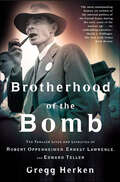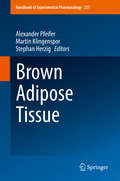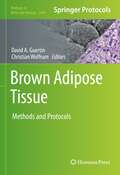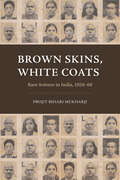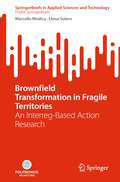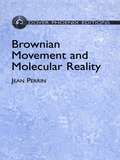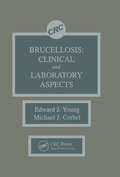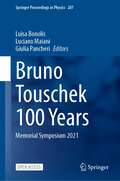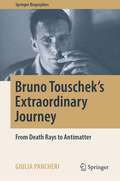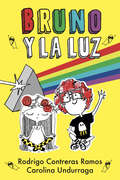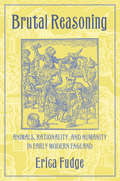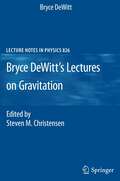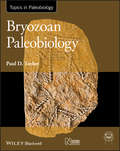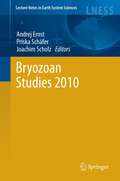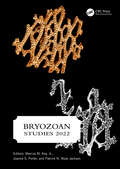- Table View
- List View
Brotherhood of the Bomb: The Tangled Lives and Loyalties of Robert Oppenheimer, Ernest Lawrence, and Edward Teller
by Gregg Herken“The scientists who made the nuclear bomb are the focus of this detailed, engrossing history of one of the greatest scientific discoveries of the 20th century.” —Publishers WeeklyThe story of the twentieth century is largely the story of the power of science and technology. Within that story is the incredible tale of the human conflict between Robert Oppenheimer, Ernest Lawrence, and Edward Teller—the scientists most responsible for the advent of weapons of mass destruction.The story of these three men, builders of the atomic and hydrogen bombs, is fundamentally about loyalty—to country, to science, and to each other—and about the wrenching choices that had to be made when these allegiances came into conflict. In Brotherhood of the Bomb, Gregg Herken gives us the behind-the-scenes account based upon a decade of research, interviews, and newly released Freedom of Information Act and Russian documents.
Brown Adipose Tissue (Handbook of Experimental Pharmacology #251)
by Stephan Herzig Alexander Pfeifer Martin KlingensporThe main focus of this book is on brown adipose tissue and its metabolic function. The book provides a timely update on the latest research and shows where the field is heading. Brown adipose tissue (BAT) dissipates energy and has received considerable attention in the last few years, having been re-discovered in adult humans in 2007/9. Moreover, BAT might offer a target for novel therapies to address obesity, a health condition that has reached pandemic dimensions.
Brown Adipose Tissue: Methods and Protocols (Methods in Molecular Biology #2448)
by David A. Guertin Christian WolfrumThis detailed volume explores techniques for researching brown adipose tissue (BAT) and the fascinating biology and therapeutic potential of thermogenic adipocytes. The content reflects the advancing technologies in genetics, imaging, and 'omics strategies that are allowing researchers to probe BAT biology at unprecedented depths and detail, yet it also presents classic physiology principles, which remain the core tenets of BAT biology. Written for the highly successful Methods in Molecular Biology series, chapters include introductions to their respective topics, lists of the necessary materials and reagents, step-by-step, readily reproducible laboratory protocols, and tips on troubleshooting and avoiding known pitfalls. Authoritative and practical, Brown Adipose Tissue: Methods and Protocols provides perspectives and detailed protocols for the benefit of both new BAT researchers looking for guidance as well as seasoned researchers who would like to expand their toolkits. Chapter 12 is available open access under a Creative Commons Attribution 4.0 International License via link.springer.com.
Brown Bears in Alaska's National Parks: Conservation of a Wilderness Icon
by Grant V. Hilderbrand Kyle Joly David D. Gustine Nina ChambersBrown bears are powerful symbols of wilderness, thriving in the vast, untamed ecosystems of Alaska’s remote national parks. Brown Bears in Alaska’s National Parks is a unique and thorough exploration of the conservation, ecology, and management of brown bears in these parks, including examinations of bear biology, human-bear interactions, population estimation methods, and the effects of climate change on bear populations. This lavishly illustrated volume offers fresh perspectives about the complex challenges that bears and humans face as they navigate coexistence in the evolving wilderness of Alaska. Through park-specific chapters, the authors clearly present the current understanding of brown bear ecology across a wide range of ecosystems—from the sparse and frigid Gates of the Arctic, entirely above the Arctic Circle, to the bountiful coast of Katmai, where the marine and terrestrial systems converge. In Glacier Bay, bears roam newly exposed ecosystems shaped by retreating glaciers, while the interior landscapes of Lake Clark and Denali provide a mix of boreal forests, tundra, rivers, and towering mountains. Brown bears—and the many species that share their habitats—face numerous challenges, with climate change among the greatest threats. The warming climate intensifies other pressures, such as industrial development, both within and around park boundaries. Management actions may also reduce native brown bear populations and, in turn, threaten healthy and naturally functioning ecosystems. The adaptability of brown bears, in concert with thoughtful and science-based management, is essential for the conservation of these majestic creatures and the wilderness landscapes on which they depend. Written by the wildlife biologists and anthropologists who have dedicated their careers to studying brown (grizzly) bears and their relationship to people, Brown Bears in Alaska’s National Parks is a premier reference for bear enthusiasts, biologists, managers, and academics, as well as advocates for wild things and wild places.
Brown Skins, White Coats: Race Science in India, 1920–66
by Projit Bihari MukharjiA unique narrative structure brings the history of race science in mid-twentieth-century India to vivid life. There has been a recent explosion in studies of race science in the twentieth and twenty-first centuries, but most have focused either on Europe or on North America and Australia. In this stirring history, Projit Bihari Mukharji illustrates how India appropriated and repurposed race science to its own ends and argues that these appropriations need to be understood within the national and regional contexts of postcolonial nation-making—not merely as footnotes to a Western history of “normal science.” The book comprises seven factual chapters operating at distinct levels—conceptual, practical, and cosmological—and eight fictive interchapters, a series of epistolary exchanges between the Bengali author Hemendrakumar Ray (1888–1963) and the protagonist of his dystopian science fiction novel about race, race science, racial improvement, and dehumanization. In this way, Mukharji fills out the historical moment in which the factual narrative unfolded, vividly revealing its moral, affective, political, and intellectual fissures.
Brown Skins, White Coats: Race Science in India, 1920–66
by Projit Bihari MukharjiA unique narrative structure brings the history of race science in mid-twentieth-century India to vivid life. There has been a recent explosion in studies of race science in the twentieth and twenty-first centuries, but most have focused either on Europe or on North America and Australia. In this stirring history, Projit Bihari Mukharji illustrates how India appropriated and repurposed race science to its own ends and argues that these appropriations need to be understood within the national and regional contexts of postcolonial nation-making—not merely as footnotes to a Western history of “normal science.” The book comprises seven factual chapters operating at distinct levels—conceptual, practical, and cosmological—and eight fictive interchapters, a series of epistolary exchanges between the Bengali author Hemendrakumar Ray (1888–1963) and the protagonist of his dystopian science fiction novel about race, race science, racial improvement, and dehumanization. In this way, Mukharji fills out the historical moment in which the factual narrative unfolded, vividly revealing its moral, affective, political, and intellectual fissures.
Brown Skins, White Coats: Race Science in India, 1920–66
by Projit Bihari MukharjiA unique narrative structure brings the history of race science in mid-twentieth-century India to vivid life. There has been a recent explosion in studies of race science in the twentieth and twenty-first centuries, but most have focused either on Europe or on North America and Australia. In this stirring history, Projit Bihari Mukharji illustrates how India appropriated and repurposed race science to its own ends and argues that these appropriations need to be understood within the national and regional contexts of postcolonial nation-making—not merely as footnotes to a Western history of “normal science.” The book comprises seven factual chapters operating at distinct levels—conceptual, practical, and cosmological—and eight fictive interchapters, a series of epistolary exchanges between the Bengali author Hemendrakumar Ray (1888–1963) and the protagonist of his dystopian science fiction novel about race, race science, racial improvement, and dehumanization. In this way, Mukharji fills out the historical moment in which the factual narrative unfolded, vividly revealing its moral, affective, political, and intellectual fissures.
Brownfield Transformation in Fragile Territories: An Interreg-Based Action Research (SpringerBriefs in Applied Sciences and Technology)
by Marcello Modica Elena SoleroThis book presents and critically evaluates the results of a European territorial cooperation project addressing the planning challenge of brownfield transformation in fragile territories. Set against the backdrop of the current scenario of deindustrialisation in the European Alps, the book describes how to read and interpret the spatial condition of industrial brownfields in peripheral mountain areas as complex transformation sites. Through key theoretical references, well-documented experiences and field activities, the book explores and advances an innovative methodology of design-based participatory planning conceived specifically for fragile socioeconomic and environmental contexts. The empirical basis for such a methodological exploration is provided by four pilot sites distributed between Austria, Italy, France and Slovenia, identified in the cooperation project as highly representative and recurring situations. The book includes a comparative review of the work carried out for the pilot sites, as well as the planning outcomes generated, providing a clear and operative reference for scholars, professionals and public officers called to face similar experiences.
Brownian Motion
by Peter Mörters Yuval PeresThis eagerly awaited textbook covers everything the graduate student in probability wants to know about Brownian motion, as well as the latest research in the area. Starting with the construction of Brownian motion, the book then proceeds to sample path properties like continuity and nowhere differentiability. Notions of fractal dimension are introduced early and are used throughout the book to describe fine properties of Brownian paths. The relation of Brownian motion and random walk is explored from several viewpoints, including a development of the theory of Brownian local times from random walk embeddings. Stochastic integration is introduced as a tool and an accessible treatment of the potential theory of Brownian motion clears the path for an extensive treatment of intersections of Brownian paths. An investigation of exceptional points on the Brownian path and an appendix on SLE processes, by Oded Schramm and Wendelin Werner, lead directly to recent research themes.
Brownian Motion, Martingales, and Stochastic Calculus (Graduate Texts in Mathematics #274)
by Jean-François Le GallThis book offers a rigorous and self-contained presentation of stochastic integration and stochastic calculus within the general framework of continuous semimartingales. The main tools of stochastic calculus, including Itô's formula, the optional stopping theorem and Girsanov's theorem, are treated in detail alongside many illustrative examples. The book also contains an introduction to Markov processes, with applications to solutions of stochastic differential equations and to connections between Brownian motion and partial differential equations. The theory of local times of semimartingales is discussed in the last chapter. Since its invention by Itô, stochastic calculus has proven to be one of the most important techniques of modern probability theory, and has been used in the most recent theoretical advances as well as in applications to other fields such as mathematical finance. Brownian Motion, Martingales, and Stochastic Calculus provides a strong theoretical background to the reader interested in such developments. Beginning graduate or advanced undergraduate students will benefit from this detailed approach to an essential area of probability theory. The emphasis is on concise and efficient presentation, without any concession to mathematical rigor. The material has been taught by the author for several years in graduate courses at two of the most prestigious French universities. The fact that proofs are given with full details makes the book particularly suitable for self-study. The numerous exercises help the reader to get acquainted with the tools of stochastic calculus.
Brownian Movement and Molecular Reality (Dover Books on Physics)
by F. Soddy Jean PerrinHow do we know that molecules really exist? An important clue came from Brownian movement, a concept developed in 1827 by botanist Robert Brown, who noticed that tiny objects like pollen grains shook and moved erratically when viewed under a microscope. Nearly 80 years later, in 1905, Albert Einstein explained this "Brownian motion" as the result of bombardment by molecules. Einstein offered a quantitative explanation by mathematically estimating the average distance covered by the particles over time as a result of molecular bombardment. Four years later, Jean Baptiste Perrin wrote Brownian Movement and Molecular Reality, a work that explains his painstaking measurements of the displacements of particles of a resin suspended in water -- experiments that yielded average displacements in excellent accord with Einstein's theoretical prediction.The studies of Einstein and Perrin provided some of the first concrete evidence for the existence of molecules. Perrin, whose name is familiar to all who employ his methods for calculations in molecular dynamics, received the 1926 Nobel Prize in physics. In this classic paper, he introduced the concept of Avogadro's number, along with other groundbreaking work. Originally published in the French journal Annates de chimie et de physique, it was translated into English by Frederick Soddy to enduring influence and acclaim.
Bruce Arrigo: Activism, Crime, and Justice (Palgrave Pioneers in Criminology)
by David PolizziThis book examines various aspects of the work of Bruce Arrigo related to therapeutic jurisprudence, criminal justice ethics, and the place of critical theory in criminology and related fields. Arrigo’s work spans over thirty years and during that time has been an important voice in the practical and theoretical application of post-modern and critical theoretical approaches to mental illness, the practice of forensic psychology, and a wide variety of critical reflection concerning incarceration, rehabilitation, and the ethical practice within the criminal justice system. Each individual contributor offers their own perspective on his work and its specific influence on the topic under discussion. This book speaks to academics focused on the application of critical criminological theory within a variety of disciplinary contexts. These include forensic psychology, psychological jurisprudence, criminal justice ethics, and philosophically based critiques of the law and mental health and criminal justice activism.
Brucellosis in the Greater Yellowstone Area
by Board On AgricultureBrucellosis, a bacterial disease, was first noted in the Greater Yellowstone Area in 1917 and has been a chronic presence there since then. This book reviews existing scientific knowledge regarding brucellosis transmission among wildlife, particularly bison, elk, and cattle, in the Greater Yellowstone Area. It examines the mechanisms of transmission, risk of infection, and vaccination strategies. The book also assesses the actual infection rate among bison and elk and describes what is known about the prevalence of Brucella abortus among other wildlife.
Brucellosis: Clinical and Laboratory Aspects
by Edward J. Young Michael J. CorbelFourteen brucellosis experts from seven countries discuss the history, epidemiology, microbiology, immunology, diagnosis, treatment, and control of brucellosis in animals and man. Edited by members of the World Health Organization's Expert Committee on Brucellosis, this text is the first comprehensive treatment of the disease since The Nature of Brucellosis by Wesley W. Spink in 1956. Topics reviewed with current references include infection caused by newer species of Brucella, such as B. canis, newer diagnostic techniques, such as radioimmunoassay and ELISA, and newer treatments, such as rifampin and the quinolones. The pathogenesis and pathophysiology of brucellosis is reviewed in depth, correlating the disease in animals with the illness in humans. This volume is extremely useful for clinicians, researchers, and students in medicine, veterinary science, microbiology, immunology, epidemiology, public health, and international health.
Bruno Latour in Pieces: An Intellectual Biography (Forms of Living)
by Henning SchmidgenBruno Latour stirs things up. Latour began as a lover of science and technology, co-founder of actor-network theory, and philosopher of a modernity that had “never been modern.” In the meantime he is regarded not just as one of the most intelligent—and also popular—exponents of science studies but also as a major innovator of the social sciences, an exemplary wanderer who walks the line between the sciences and the humanities.This book provides the first comprehensive overview of the Latourian oeuvre, from his early anthropological studies in Abidjan (Ivory Coast), to influential books like Laboratory Life and Science in Action, and his most recent reflections on an empirical metaphysics of “modes of existence.” In the course of this enquiry it becomes clear that the basic problem to which Latour’s work responds is that of social tradition, the transmission of experience and knowledge. What this empirical philosopher constantly grapples with is the complex relationship of knowledge, time, and culture.
Bruno Touschek 100 Years: Memorial Symposium 2021 (Springer Proceedings in Physics #287)
by Luciano Maiani Luisa Bonolis Giulia PancheriThis open access book celebrates the contribution of Bruno Touschek to theoretical physics and particle colliders in Europe. It contains direct testimonials from his former students, collaborators, and eminent scientists, among them, two Nobel Prize winners in Physics, Giorgio Parisi and Carlo Rubbia. It reviews the main developments in theoretical and accelerator physics in the second half of the twentieth century, while at the same time providing an overview of future prospects worldwide. This book is unique in that it will be of interest to historians of physics and also to the younger generation of researchers. Through the contribution of the leading protagonists, the interested scholar will learn about the past, present status, and relevance of both theoretical and experimental accelerator physics. The overview of Bruno Touschek’s life and works across Europe, from pre-war Vienna to Germany, the UK, Italy, and France, adds a human dimension to the scientific narration, while the open access status makes this laudatory book available to anyone with interest.
Bruno Touschek's Extraordinary Journey: From Death Rays to Antimatter (Springer Biographies)
by Giulia PancheriThis book tells the story of a unique scientific and human adventure, following the life and science of Bruno Touschek, an Austrian born physicist, who conceived and built AdA, the first matter-antimatter colliding-beam storage ring, the ancestor of the Large Hadron Collider at CERN where the Higgs Boson was discovered in 2012. Making extensive use of archival sources and personal correspondence, the author offers for the first time a unified history of European efforts to build modern-day particle accelerators, from the dark times of war-ravaged Europe up to the rebuilding of science in Germany, UK, Italy and France through the 1950s and early 1960s. This book, the result of several years of scholarly research work, includes numerous previously unpublished photos as well as original drawings by Bruno Touschek.
Bruno y la luz
by Rodrigo Contreras Carolina UndurragaEl segundo título de la serie de ficción que acerca la ciencia a l@s niñ@s En esta segunda entrega, Bruno recibe de regalo un telescopio, que resulta ser ¡una verdadera máquina para viajar en el tiempo! Así, y con la ayuda de su sabio amigo Hidrógenes, descubrirá el mensaje que trae la luz de las estrellas: un secreto que ha viajado por miles de millones de años y que guarda la historia del universo. Además, resolverá preguntas que se ha hecho siempre: ¿por qué el cielo es azul?, ¿por qué titilan las estrellas?, ¿por qué un zancudo puede picar a un humano a pesar de estar en una pieza completamente oscura? La serie continúa en: Bruno y las estrellas. Este libro explicará qué son las estrellas, cómo nacen, cuánto tiempo viven y cómo, a partir de su existencia, se crean todos los otros átomos que no aparecieron en el Big Bang y que dieron vida a nuevas estrellas y planetas. Bruno y la vida en el espacio. En esta aventura, Bruno viaja a la estación espacial internacional, donde viven los astronautas, a 400 kilómetros de la Tierra. ¡Imagina cómo es observar la vida en gravedad cero!
Brutal Reasoning: Animals, Rationality, and Humanity in Early Modern England
by Erica FudgeEarly modern English thinkers were fascinated by the subject of animal rationality, even before the appearance of Descartes's Discourse on the Method (1637) and its famous declaration of the automatism of animals. But as Erica Fudge relates in Brutal Reasoning, the discussions were not as straightforward—or as reflexively anthropocentric—as has been assumed. Surveying a wide range of texts-religious, philosophical, literary, even comic-Fudge explains the crucial role that reason played in conceptualizations of the human and the animal, as well as the distinctions between the two. Brutal Reasoning looks at the ways in which humans were conceptualized, at what being "human" meant, and at how humans could lose their humanity. It also takes up the questions of what made an animal an animal, why animals were studied in the early modern period, and at how people understood, and misunderstood, what they saw when they did look.From the influence of classical thinking on the human-animal divide and debates surrounding the rationality of women, children, and Native Americans to the frequent references in popular and pedagogical texts to Morocco the Intelligent Horse, Fudge gives a new and vital context to the human perception of animals in this period. At the same time, she challenges overly simplistic notions about early modern attitudes to animals and about the impact of those attitudes on modern culture.
Bryce DeWitt's Lectures on Gravitation: Edited by Steven M. Christensen (Lecture Notes in Physics #826)
by Steven M. Christensen Bryce DewittBryce DeWitt, a student of Nobel Laureate Julian Schwinger, was himself one of the towering figures in 20th century physics, particularly renowned for his seminal contributions to quantum field theory, numerical relativity and quantum gravity. In late 1971 DeWitt gave a course on gravitation at Stanford University, leaving almost 400 pages of detailed handwritten notes. Written with clarity and authority, and edited by his former student Steven Christensen, these timeless lecture notes, containing material or expositions not found in any other textbooks, are a gem to be discovered or re-discovered by anyone seriously interested in the study of gravitational physics.
Bryology for the Twenty-first Century (Maney Main Publications)
by Jeffrey W. BatesA compilation of state of the art papers on key topics in bryology from invited speakers at the Centenary Symposium, University of Glasgow, 57 August 1996.
Bryophyte Development: Physiology and Biochemistry (Routledge Revivals)
by R. N. Chopra Satish C. BhatlaPublished in 1990: With the accumulation of knowledge in the newer areas of investigations and the increasing degree of specialization, the most satisfactory way of bringing together authentic information in one volume is to invite the specialists in each area to contribute.
Bryozoan Paleobiology (TOPA Topics in Paleobiology)
by Paul D. TaylorBryozoa are among the most abundant yet least understood of phyla in the fossil record. These exclusively colonial animals can be traced back to the Ordovician as fossils and are common elements of sediments deposited in shallow marine environments. On occasion their calcareous skeletons are sufficiently numerous to produce bryozoan limestones. The potential of bryozoans in facies analysis, and their use in macroevolutionary studies, have both been widely recognised, but to date have been incompletely exploited. Bryozoan Paleobiology brings together the scattered research on living and fossil bryozoans in broad and profusely illustrated overview that will help students and researchers alike in understanding this fascinating group of animals. Beginning with the basics of bryozoan morphology, ecology and classification, the book progresses from the smallest scale of skeletal ultrastructure, to the largest of bryozoan distributions in time and space. On the way, topics such as the origin of zooidal polymorphism and macroevolutionary trends in colony forms are covered. Case studies illuminate these topics, and areas in which further research is particularly required are highlighted.
Bryozoan Studies 2010 (Lecture Notes in Earth System Sciences #143)
by Andrej Ernst Joachim Scholz Priska SchäferBryozoa are a colonial animal phylum with a long evolutionary history, having existed from the early Ordovician (480 My) onward and still flourishing today. Several mass extinctions in earth history shaped and triggered bryozoan evolution through drastic turnover of faunas and new evolutionary lineages. Bryozoa are widespread across all latitudes from Equator to Polar Regions and occur in marine and freshwater environments. They are shaping benthic ecosystems and recording ambient environmental conditions in their skeletons. The book provides a synthesis of the current main topics of research in the field of Bryozoology including combined research on both extant, and extinct taxa. Fields or current research span molecular genetics and phylogeny, life history, reproduction and anatomy, biodiversity and evolutionary patterns in time and space, taxonomy, zoogeography, ecology, sediment interactions, and climate response.
Bryozoan Studies 2022: PROCEEDINGS OF THE NINETEENTH INTERNATIONAL BRYOZOOLOGY ASSOCIATION CONFERENCE (DUBLIN, IRELAND, 22-26 AUGUST 2022)
by Marcus M. Key Joanne S. Porter Wyse Jackson, Patrick N.Bryozoan Studies 2022 contains nineteen papers presented at the 19th International Conference of the International Bryozoology Association held at Trinity College Dublin in August 2022. Bryozoans are complex and fascinating colonial organisms that range from Cambrian to the present day and which are found in marine and freshwater environments from pole to pole and subtidal to abyssal. Recent tomographic techniques have revolutionised the study of modern and fossil taxa where internal structures are revealed through non-destructive methodologies. Here the internal structure of some Ordovician and Eocene taxa is illustrated through these methods. Phylogenetic studies of bryozoans question the classic classification of the group; here the phylogeny of species from California and Japan is described. Other topics covered are assessments of Recent faunas from Haiti and fossil assemblages from Mexico and the United States. Distributional patterns from the Arctic and New Zealand and the dispersal patterns of bryozoans on rafted pumice and on slipper lobsters are characterised. Further contributions provide descriptions of a rare Permian taxon, clarification of species assigned to the Upper Palaeozoic genus Stenopora, avicularia in Wilbertopora, enigmatic structures in a fenestrate bryozoan, repair structures in trepostomes, and an assessment of skeletonisation in the families of Palaeozoic orders.
